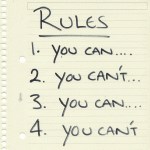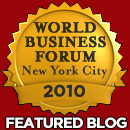 [tweetmeme]“Authentic” is undoubtedly one of most echoed words in the Social World nowadays – applied especially liberally when explaining to companies the means by which they should be conveying themselves to the broader world in order to be heard.
[tweetmeme]“Authentic” is undoubtedly one of most echoed words in the Social World nowadays – applied especially liberally when explaining to companies the means by which they should be conveying themselves to the broader world in order to be heard.
The term seems seldom explained more than that, and yet the implications are deep. It amuses me to no end that the word “authentic” has staged such an emergent come back into our vocabulary – not least of which when used to describe a media and communication form so recently embraced for its ability to allow people to engage in an almost schizophrenic array of multiple online personalities.
 Ironic then, that in the current online world that we’ve created, where it’s so easy to be anyone or anything you can imagine, it’s never been so important to simply be yourself. That in a world of Avatars, Second Lives, and Virtual Worlds – we want to know that we’re communicating with real people who are being their real selves.
Ironic then, that in the current online world that we’ve created, where it’s so easy to be anyone or anything you can imagine, it’s never been so important to simply be yourself. That in a world of Avatars, Second Lives, and Virtual Worlds – we want to know that we’re communicating with real people who are being their real selves.
Maybe it’s a sign that the Social World is growing up – moving from a prior youthfulness happy to live in a world sporting fake Rolexes and toting counterfeit Louis Vuitton bags; to a decidedly a more mature mode preferring to spend their newfound wealth buying the real thing on 5th Avenue.
The formula for being “authentic” as an individual must surely be simple then: Be yourself, communicate from the heart and be consistent. But how do you achieve that in an enterprise setting? How does a company made up of thousands of voices come across with the same effectiveness as one? Here are some guidelines for your internal “social champions” to follow:
 1) and 2) “Know Who You Are and Live It” – Earlier this year I had the good fortune to go to the Front End of Innovation Conference in Boston where Bert Jacobs, one of the founders of “Life is Good” was speaking. In his speech, he relayed the story of how the two brothers started their fledgling business on a street corner selling t-shirts and how they were able to translate that into the marketing empire that Life is Good is now.
1) and 2) “Know Who You Are and Live It” – Earlier this year I had the good fortune to go to the Front End of Innovation Conference in Boston where Bert Jacobs, one of the founders of “Life is Good” was speaking. In his speech, he relayed the story of how the two brothers started their fledgling business on a street corner selling t-shirts and how they were able to translate that into the marketing empire that Life is Good is now.
During his session there was a comment – one that he repeated during his speech, and then signed along with his name on the Frisbee he flung into the audience and pinged me squarely on the forehead with (there was a ricochet involved from a nearby audience member – honest!).
The comment was “know who you are, and live it”. Now Bert’s no social media guru, nor is he making money from his insight (I believe he donates a lot of his speaking fees to charity – He’s a quiet, down to earth, and confident guy who’s simply figured out the secret to his success.
That secret has helped him translate a feeling, an emotion, and a mission from his heart to his products – and onwards to his customers.
This effect though is multiplied in the social world and the necessity to “know who you are” with ultimate certainty and to consistently live out those values in the social worlds is the real key to success for corporations in what has to be one of the ultimate brand challenges of the modern business world.
 Why the “ultimate” brand challenge? Because the Social World has an incredible memory – infinite actually.
Why the “ultimate” brand challenge? Because the Social World has an incredible memory – infinite actually.
What you say, what you do, how you do it, and who you do it with is preserved along with people’s opinions of your actions from the moment it happens, until the end of time. Like an elephant on steroids, your image in the social world is established by your actions, and remembered forever.
If “Knowing Who You Are” is number 1) on the list of things companies must do – then “Live It” has to be number 2). Consistency is a key element of authenticity – people want to know that you not only “talk the talk”, but also “walk the walk”. One communication effort can set an intention, but it takes consistency to set an image.
 A positive Social Image is a fragile entity and is re-enforced or recast depending on your actions, engendering strong levels of customer loyalty and advocacy to those who get it right – and equally strong negative reactions to those who trip up on the path. Never mind women, hell hath no fury like a customer scorned in the social world – where one negative voice can sound like hundreds online.
A positive Social Image is a fragile entity and is re-enforced or recast depending on your actions, engendering strong levels of customer loyalty and advocacy to those who get it right – and equally strong negative reactions to those who trip up on the path. Never mind women, hell hath no fury like a customer scorned in the social world – where one negative voice can sound like hundreds online.
The need for consistency in your actions is then further exaggerated in the current Google-centric world where information is omnipresent and easy to access. In this world, it’s not just your actions that matter, but those of everyone you associate with too. Nestlé’s well publicized controversy regarding the source of Palm Oil used in some of their confectionary is just one example of this in action.
3) Be Real – The Social World is made up of individuals – not corporations. Talk to them in the same formal way you approach your PR campaigns and you’ll find the same level of interest and disengagement you probably got from journalists when you sent them that Press Release announcing your new six sigma process (yaaawwwwnn).
 Interactions with actual people and personalities are simply more “sticky” than formal corporate approaches. Whilst it’s important to institute guidelines and rules for those interactions, you should, whenever possible, make sure that your company’s interactions come across as being made on a person-to-person basis and not on a corporate entity-to-whomever-will-listen basis.
Interactions with actual people and personalities are simply more “sticky” than formal corporate approaches. Whilst it’s important to institute guidelines and rules for those interactions, you should, whenever possible, make sure that your company’s interactions come across as being made on a person-to-person basis and not on a corporate entity-to-whomever-will-listen basis.
 4) Be Transparent – Part of the potential poisoned chalice that can be connecting to thousands of people is that you’ll find it very hard to hide information – so don’t bother doing so! Treat your social world as if they’re an integral part of your company. Let them know early when good news is underway, and apologize early when you screw up. Open up to your community and they’ll reward you with understanding, forgiveness, and loyalty.
4) Be Transparent – Part of the potential poisoned chalice that can be connecting to thousands of people is that you’ll find it very hard to hide information – so don’t bother doing so! Treat your social world as if they’re an integral part of your company. Let them know early when good news is underway, and apologize early when you screw up. Open up to your community and they’ll reward you with understanding, forgiveness, and loyalty.
5) Cultivate Relationships, not Transactions – Treat the communities you interact with as if they were integral partners in your company’s success and not just simply a transaction source. Care about them, ensure they get value out of the relationship then have with you, and make sure the flow of information and value goes both ways.
6) Do it yourself – This last one is the simplest – you want to be yourself? You want to be “real”? You want to cultivate lasting relationships with your social community? Then do it yourself – don’t hire external partners to do it for you.
 Partners have their role in all this – as teachers, thought leaders, and general resources – but you shouldn’t rely on them for execution – that’s just lazy, and in an age of transparency, it won’t take long for the social world to see through you.
Partners have their role in all this – as teachers, thought leaders, and general resources – but you shouldn’t rely on them for execution – that’s just lazy, and in an age of transparency, it won’t take long for the social world to see through you.
Invest in the internal capabilities and expertise to drive and deliver value to and from your communities and the returns will be hundred-fold.
Got more tips on how to be Authentic? Share them below!









